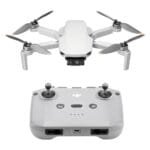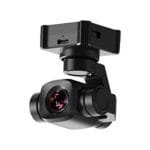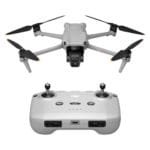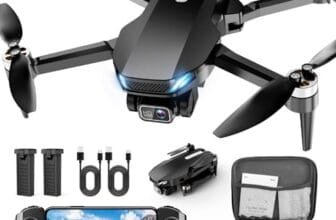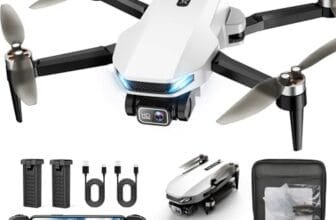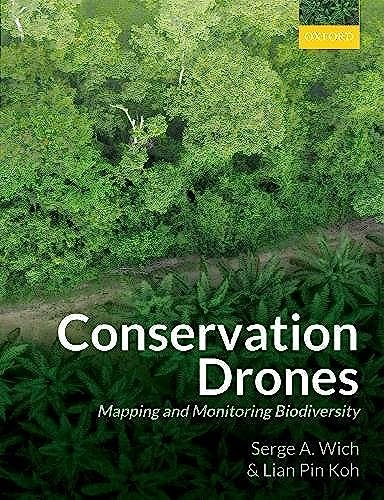
Drones have become vital tools for wildlife conservation. They help scientists map habitats and monitor animal populations efficiently.
In recent years, technology has transformed efforts to protect wildlife. Drones offer a bird’s-eye view, making it easier to track and study animals without disturbing their natural behaviors. From mapping biodiversity to monitoring endangered species, drones provide valuable data that can guide conservation strategies.
Books like “Conservation Drones: Mapping and Monitoring Biodiversity” and “Tech in Wildlife Conservation: A Hands-On Guide” illustrate the practical applications of drones and sensors in the field. These resources explore how technology aids in saving species, such as sea turtles, by offering unique insights. Embracing these tools can lead to more effective conservation efforts, ensuring a healthier planet for future generations.
Conservation Drones: Mapping And Monitoring Biodiversity

Conservation Drones: Mapping and Monitoring Biodiversity is an ideal purchase for environmental scientists, wildlife enthusiasts, and conservationists who are keen on using cutting-edge technology for biodiversity mapping and monitoring. This book is perfect for those who wish to understand the application of drones in the conservation sector and are looking to enhance their research or fieldwork with innovative techniques.
Pros:
- Provides a comprehensive guide to using drones for biodiversity monitoring.
- Published by the reputable Oxford University Press, ensuring high-quality content.
- Compact dimensions make it easily portable for field researchers.
- Written by experts, offering in-depth insights into conservation technology.
Cons:
- The book’s technical content may be challenging for beginners.
- Limited to 132 pages, which might not cover every aspect of drone technology.
The features of Conservation Drones: Mapping and Monitoring Biodiversity are particularly focused on how drones can revolutionize the way we approach wildlife conservation. With detailed explanations on the technical aspects and practical applications of drones, the book empowers users to implement effective biodiversity monitoring strategies. By utilizing advanced aerial technology, conservationists can gain a bird’s-eye view of habitats, enabling more accurate data collection and monitoring of species at risk.
One of the standout benefits for users is the book’s ability to bridge the gap between theoretical knowledge and practical application. Readers are guided through various case studies and real-world examples, demonstrating the success of drone use in conservation projects. This practical approach not only enhances the reader’s understanding but also inspires them to adopt similar innovative methods in their own work, potentially leading to more effective conservation efforts worldwide.
To buy this product, click here.
Tech In Wildlife Conservation: A Hands-on Guide To Saving Species With Drones, Sensors & Data

This guide is perfect for conservationists, wildlife enthusiasts, and tech-savvy individuals who are eager to integrate modern technology into wildlife conservation efforts. If you’re passionate about using drones, sensors, and data to make a tangible impact on saving species, this hands-on guide is tailored for you.
Pros:
- Comprehensive coverage of drones, sensors, and data applications in conservation.
- Practical insights for real-world implementation.
- Innovative approaches to traditional conservation methods.
Cons:
- Limited page count may restrict depth of some topics.
- Requires a basic understanding of technology.
The guide delves into how drones can be deployed to monitor wildlife populations, providing a bird’s-eye view of habitats that are often difficult to access. This technology allows for efficient tracking of animal movements, which is crucial for developing effective conservation strategies. Drones also help in documenting changes in ecosystems over time, offering invaluable data to researchers.
Sensors play a key role in gathering environmental data, such as temperature, humidity, and sound levels, which can directly impact species survival. The guide explains how to set up and utilize sensor networks to collect precise data, helping conservationists make informed decisions. Additionally, the integration of data analytics in wildlife conservation is highlighted, showing how patterns and trends can be identified to predict potential threats and mitigate risks.
To buy this product, click here.
Wildlife Conservation Technology

The ideal customer for Wildlife Conservation Technology (Searchlight Books ™ — Saving Animals with Science) is anyone passionate about wildlife conservation and interested in learning how science and technology are being used to protect endangered species. This book is perfect for educators, students, and environmental enthusiasts who want a comprehensive understanding of modern conservation efforts.
Pros:
- Provides an in-depth look at modern conservation technologies.
- Ideal for educational purposes and classroom settings.
- Encourages awareness and engagement in wildlife conservation.
Cons:
- Limited page count might not satisfy detailed research needs.
- Publication date might lead to outdated information as technology evolves.
Wildlife Conservation Technology explores cutting-edge technological advancements in the field of wildlife conservation. It delves into the use of drones, satellites, and genetic engineering to track and protect endangered species. These technologies offer significant benefits such as increased efficiency in tracking animal movements and better data collection for researchers, ultimately aiding in more effective conservation strategies.
The book also highlights the role of science in developing solutions to combat threats like poaching and habitat destruction. By integrating scientific research and technological innovation, conservationists can implement targeted actions to mitigate these threats. This empowers readers to understand the importance of interdisciplinary approaches in solving complex environmental issues and inspires them to support or participate in conservation initiatives.
To buy this product, click here.
Sea Turtle Research And Conservation: Lessons From Working In The Field

The ideal customer for “Sea Turtle Research and Conservation: Lessons From Working In The Field” is anyone passionate about marine biology, environmental conservation, or wildlife research. This book is perfect for students, academics, and professionals seeking to deepen their understanding of sea turtle conservation practices and the challenges faced in the field. It provides invaluable insights and lessons learned from real-world experiences, making it an essential resource for those looking to contribute to marine conservation efforts.
Pros:
- Offers comprehensive insights into sea turtle conservation and research methodologies.
- Written by experts, ensuring credibility and accuracy.
- Engaging and informative content suitable for both novices and experienced researchers.
- Provides practical examples and case studies from the field.
Cons:
- May be too technical for casual readers not familiar with scientific terminology.
- Focuses primarily on sea turtles, limiting broader marine conservation insights.
- Price may be a barrier for some interested readers.
One of the standout features of this book is its focus on hands-on experiences in the field of sea turtle research. Readers are exposed to real-life scenarios and challenges faced by conservationists, providing a practical perspective that is often missing in purely theoretical texts. This approach not only enriches the reader’s understanding but also prepares them for real-world applications in their own conservation efforts.
Additionally, the book delves into the strategies and techniques used in sea turtle conservation, offering readers a step-by-step guide to effective research practices. By learning from the successes and failures experienced by professionals in the field, readers can develop a more nuanced approach to their own work. The inclusion of case studies further enhances the learning experience, providing context and depth to the conservation techniques discussed.
To buy this product, click here.
Tech In Wildlife Conservation

The ideal customer for “Tech in Wildlife Conservation: The Definitive Playbook for Using Technology to Save Species” is anyone passionate about wildlife conservation, environmental technology enthusiasts, and professionals in the conservation field. Individuals looking to gain a comprehensive understanding of how technology can be leveraged to protect endangered species will find this playbook invaluable. If you are a researcher, student, or a policy maker eager to explore innovative solutions to environmental challenges, this book is tailored for you.
Pros:
- Comprehensive guide on using technology in conservation efforts.
- Cutting-edge insights from industry experts and researchers.
- Practical strategies for implementing technology in real-world scenarios.
- Up-to-date information with a publication date of 2025.
Cons:
- Limited page count may not cover all aspects in depth.
- Specific focus on technology may not appeal to traditional conservationists.
“Tech in Wildlife Conservation: The Definitive Playbook for Using Technology to Save Species” offers an in-depth exploration of how modern technology can be integrated into conservation efforts to tackle the ever-growing challenges faced by endangered species. With 84 pages packed with valuable insights, this playbook serves as a critical resource for those seeking to innovate within the conservation sphere. The publication date of 2025 ensures that readers are getting the most current perspectives and methodologies available.
The playbook dives into various technological advancements, such as drones, AI, and big data analytics, and their applications in wildlife conservation. By adopting these technologies, conservationists can achieve greater efficiency and accuracy in monitoring species populations, assessing habitats, and implementing strategic interventions. The book emphasizes the importance of collaboration between technologists and conservationists, offering case studies and success stories that illustrate how technology has already made a significant impact in the field.
To buy this product, click here.
Frequently Asked Questions
How Do Drones Help In Wildlife Conservation?
Drones aid wildlife conservation by providing aerial views for mapping and monitoring. They help track animal movements, assess habitat changes, and gather crucial data. This technology enhances the efficiency of conservation efforts and reduces human intrusion into sensitive ecosystems.
What Technologies Are Used In Wildlife Conservation?
Wildlife conservation utilizes drones, sensors, and data analytics. These technologies help in species monitoring, habitat assessment, and threat detection. They provide valuable insights, enabling conservationists to make informed decisions and implement effective strategies for species protection.
Why Is Mapping Biodiversity Important?
Mapping biodiversity is crucial for understanding species distribution and ecosystem health. It helps identify critical habitats and monitor changes over time. This information guides conservation efforts, ensuring resources are allocated effectively to protect biodiversity and maintain ecological balance.
How Do Drones Aid Sea Turtle Research?
Drones offer a non-intrusive method for monitoring sea turtle populations. They capture aerial images and videos, providing valuable data on nesting sites and movements. This helps researchers understand turtle behavior, assess threats, and implement effective conservation strategies to protect these endangered species.
What Is A Wildlife Conservation Playbook?
A wildlife conservation playbook is a comprehensive guide for using technology to save species. It outlines strategies, tools, and best practices for integrating tech solutions into conservation efforts. This resource helps organizations and individuals effectively utilize technology to enhance their conservation initiatives.
Conclusion
Drones are transforming wildlife conservation efforts. They help map and monitor biodiversity. They provide crucial data for researchers. These devices play a key role in protecting endangered species. From sea turtles to more elusive creatures, drones offer new ways to gather information.
They help scientists understand animal behavior and habitats. This technology also assists in tracking animals and assessing threats. Using drones reduces human disturbance in sensitive areas. It allows conservationists to focus resources where they matter most. The tools and guides mentioned offer insights into effective use of drones.
They provide valuable lessons from field experiences. As technology advances, drones will become even more essential. They offer hope for protecting our planet’s precious wildlife. With commitment and smart technology, we can make a difference. Wildlife conservation is a shared responsibility.
Drones are just one piece of the puzzle, but a powerful one. Together, we can protect and preserve nature.

